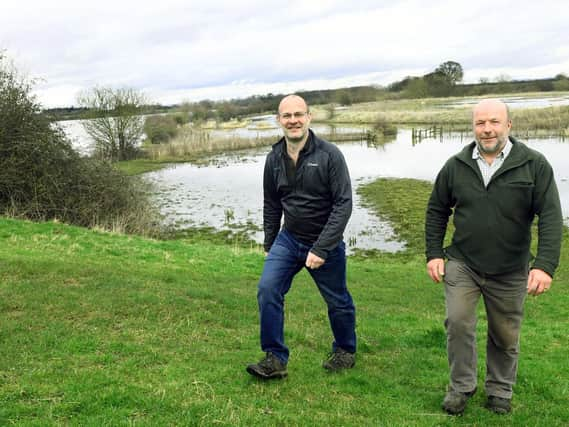A new Yorkshire based network is working to restore hay meadows


Hay making was once a cornerstone of the livestock industry, especially in the days of the heavy horse providing very real horsepower through the centuries prior to farm mechanisation.
The phrase relates to a time when it was important that when the sun shone there was work to be done, as hay is meant to be harvested when dry or with the minimum of moisture.
Advertisement
Hide AdAdvertisement
Hide AdToday’s grassland on farms delivers both hay and silage as animal feed and both have their parts to play with hay generally regarded as more palatable due to its high sugar content and silage more digestible, but the old familiar country meadows that contained wildflowers and were more specifically regarded as hay meadows have largely disappeared.
The couple who have never lived more than 200 yards apart and created a Longhorn cattle dynastyFarmers, landowners and local residents - the volunteer groups providing 'eyes and ears' for North Yorkshire PoliceExperts talk of 97 per cent of the UK’s lowland wildflower hay meadows having been lost since the days prior to farm mechanisation, but there are moves afoot to avert the decline and bring back flower-rich hay meadows through a combination of farm business, ecological benefits and their natural beauty.
Newly-formed Yorkshire-based organisation Vales, Wolds & Moors Meadows Network has been formed following initial meetings last year and will host Making Meadows at Askham Bryan College on Wednesday, April 8.
Craig Ralston, senior reserve manager of Lower Derwent Valley National Nature Reserve at Wheldrake, where he is responsible for 2,500 acres of seasonally flooded wet grassland has been involved with the setting up of the new collective that aims to bring together those who look after, manage, create and restore meadows to share experience, knowledge and resources as hay meadows become more popular.
Advertisement
Hide AdAdvertisement
Hide Ad“The reason why hay meadows went on the decline is a complex issue with many factors. Centuries ago hay meadows would have been a really important part of the management of the farm, because of grazing and making hay for over wintering of cattle and sheep. Hay meadows were integral to the farming system.
“In more recent times, farmers have either specialised in arable production or livestock. If you specialised in livestock the pressure was on to fertilise meadows to get more yield to produce more grass and while it might do so, by producing more grass in the same acreage, you lose the flowers that can’t compete such as rare species like the marsh orchid.
“So, farming has ended up with silage grass fields or grass heavy fields that haven’t all the wonderful old species.
“Farmers can get a bad press about all kinds of things but they are genuinely the guardians of the countryside. What has become clear in forming this network is that there are quite a few farmers already actively engaged in their own hay meadow restoration. Either because hay medows produce good quality hay and haylage, enriched by the flowers with each species adding its own minerals and nutrients or given changes to agri-environmental stewardship and new land management schemes that deliver public benefit from public money.”
Advertisement
Hide AdAdvertisement
Hide AdEnriched hay and haylage is of particular benefit to those farmers who have developed produce in the horse feed market, but Craig stresses that not every hay meadow will automatically be as successful as another.
“There are certain things that dictate whether a hay meadow will be as successful or not. Soil fertility is one determining factor at the outset, but putting land back to grass and starting to manage it as a traditional hay meadow will see species appear over time.
“It helps to put in some donor seed and that’s where we are able to help from Wheldrake as we harvest seed from our meadows and can let a certain amount of ours go to assist growth at other sites whether on farms, grass verges or village greens.”
Soil health is a current buzz topic in agriculture and any ecological world looking at wildlife, insects and bird life. Craig sees everything as inter-related.
Advertisement
Hide AdAdvertisement
Hide Ad“To me this isn’t a nature/conservation thing, it is really about delivering an important habitat that we have lost, but also in bringing that back we are also preventing soils from further erosion.
“The farming community has always been passionate about hay meadows and there has always been an interest in hay meadow restoration but there currently seems to be a growing interest more generally, perhaps due to greater awareness of the ecological situation.
“When we held a meeting at The Drovers Arms in Skipwith in autumn last year I was expecting maybe 20-30 if everyone turned up who had shown an initial interest, but we ended up with 75 from local farmers, conservation bodies, parish councils and private individuals.
“It proved to me there is clearly a market out there for bringing people together and exchanging views, giving greater knowledge and improving our hay meadows.
Advertisement
Hide AdAdvertisement
Hide AdThat’s why we have now come together in a more formal way as Vales, Wolds and Moors Meadows Network which will host its first public meeting next month.”
Rosy Eaton who farms with her partner, Fraser Hugill, in Ryedale is chair of the network and tells of her hopes for its future success.
“Personally, I’m excited about the network because meadows are such valuable things. It’s also exciting as meadows are a good news story about farming and the environment.
“As cattle farmers, Fraser and I feel a bit downcast at the moment that livestock is coming in for so much criticism about its environmental impact and little attention is being given to the positive environmental impacts it can have.”
Making Meadows is to be held at Askham Bryan College on Wednesday, April 8. £5 entry, starting at 7pm.